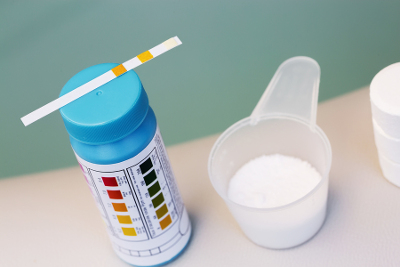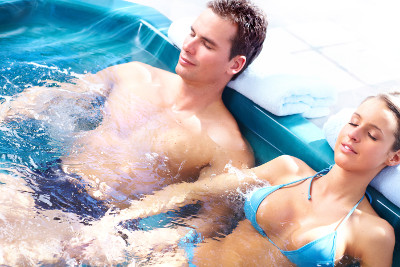If you’re new to hot tubbing, you might not have realised just how much chemistry is involved! One of the most important parts of hot tub chemistry is your pH level. Your pH levels are one of the key things that your hot tub’s performance is built on, so it’s important to get them right. At first, this can be easier said than done – it can feel a bit like a school science project as you dump tiny amounts of chemicals into your water to get your pH levels just right. But what actually is this sweet spot and why is it so important?
This simple guide will help you keep your hot tub pH perfect without the hassle. We’ll explain what it is and how to maintain it, so keep reading!
What is pH?
You probably remember a bit about pH from your school chemistry lessons. In short, it’s a measure of how acidic or alkaline something is. It’s measured on a scale of 0 to 14, with low numbers being more acidic and high numbers being more alkaline (also known as basic for reasons we’ll explain later). 7 is considered pH neutral.
Why is Hot Tub pH So important?
 Having your pH levels too high or too low can lead to a host of hot tub problems. If they’re too low – meaning your water is too acidic – it can corrode the inner workings of your hot tub, causing potentially expensive damage to important parts of your system. It can also cause your chlorine or bromine to work less effectively, which leaves your water less hygienic.
Having your pH levels too high or too low can lead to a host of hot tub problems. If they’re too low – meaning your water is too acidic – it can corrode the inner workings of your hot tub, causing potentially expensive damage to important parts of your system. It can also cause your chlorine or bromine to work less effectively, which leaves your water less hygienic.
If your water pH is too high – meaning it’s basic – this also causes problems. It leads to an increased build-up of limescale inside your hot tub system, which can cause blockages and other problems. Basic water also results in an unhygienic hot tub as it stops your filter system from working as effectively.
You might think that means getting your pH perfectly neutral is the way to go, but that’s not quite right. Perfectly neutral water with a pH level of 7 can still cause rusting and corrosion of your hot tub’s inner workings. So, what actually is the perfect level for hot tub pH?
The Perfect Hot Tub pH Levels
Ideally, you want your hot tub levels to be between 7.4 and 7.6. Some makes of hot tubs may give you a wider margin to aim for, so it’s worth checking with the manufacturer of your spa first.
Alkaline and Total Alkalinity
Why is alkaline water called “basic”? Well, it’s to separate it from total alkalinity (TA), which is a slightly different but related thing. Total alkalinity is a measurement of any alkaline substance that’s in your hot tub water. It’s important because it acts as a sort of buffer that keeps your pH levels more stable. It tells you how well your water can resist changes in pH, making balancing pH levels much easier. It does not necessarily mean your water’s pH is more alkaline – this is an important distinction!
We measure total alkalinity in PPM (parts per million). The ideal range is usually anywhere between 80-120 PPM, but the exact number you should be aiming for depends on the acidity of the other chemicals you’re using. For example, if the chlorine you use is acidic (with a low pH), you should aim for close to 120 PPM. If you’re using a liquid chlorine these tend to be more alkaline, so you’ll want to keep your total alkalinity closer to 80 PPM.
As with anything, it’s important to make sure your hot tub’s total alkalinity isn’t too high or too low. Having it fall too low is worse, as it means your water’s pH will fluctuate wildly. If it’s too low, it means your hot tub water will be more affected by acidic things, causing the pH levels to drop sharply. If total alkalinity is too high, it’ll mean your water won’t be affected by acidic things, even when you want it to be (such as when you’re adding pH reducers – more on these later), so you’ll end up with a very high pH that’s tough to bring down.
Balancing Your Hot Tub Water
 If your hot tub is inside the acceptable pH range, we say it’s balanced. Note that pH balanced isn’t the same as pH neutral – this is something that can confuse people, so bear it in mind! However, keeping it there isn’t always as easy as it sounds.
If your hot tub is inside the acceptable pH range, we say it’s balanced. Note that pH balanced isn’t the same as pH neutral – this is something that can confuse people, so bear it in mind! However, keeping it there isn’t always as easy as it sounds.
Anything that goes into your hot tub water has an effect on pH. The most common culprit? You! Human skin has a pH level of 5.5, so whenever you jump into the tub, the skin flakes and oil that washes off you will make the water more acidic over time. Showering before you jump in the tub will help relieve this problem, but acid rainwater, bits of dirt, and plant matter that end up in the water will also have an effect as well as any chemicals that you add, so your hot tub pH is something you’ll constantly need to monitor. However, provided you look after your total alkalinity, you shouldn’t need to constantly add pH adjusters to your water to keep it balanced!
You can do this with a pH measuring kit which will change colour depending on the pH of your water. You can also get digital pH testers which will just give you a number.
How to Balance Your Hot Tub Water
 Provided you keep your total alkalinity in check, balancing your pH shouldn’t be too difficult. Every hot tub owner should have a stash of pH reducers (such as sodium bisulphate) and pH increasers (soda ash is the most common) in the house at all times. Adding these to your water will allow you to make the minute adjustments you need to get the pH at the right level, but bear in mind they can also affect your total alkalinity as well. To hit your target of between 7.4 and 7.6 pH, you’ll need to check both your pH and your total alkalinity to make sure it stays stable. You don’t want to constantly
Provided you keep your total alkalinity in check, balancing your pH shouldn’t be too difficult. Every hot tub owner should have a stash of pH reducers (such as sodium bisulphate) and pH increasers (soda ash is the most common) in the house at all times. Adding these to your water will allow you to make the minute adjustments you need to get the pH at the right level, but bear in mind they can also affect your total alkalinity as well. To hit your target of between 7.4 and 7.6 pH, you’ll need to check both your pH and your total alkalinity to make sure it stays stable. You don’t want to constantly
Make sure to keep checking your pH levels whenever you add chlorine, water clarifier, or other water treatments. It sounds like a lot of work, but you’ll soon get a feel for how much works with your hot tub. When you’re just starting out, though, always check the labels of your spa chemicals carefully before you add them. This will give you an idea of how they affect your pH and total alkalinity and will take a lot of the guesswork out of water maintenance.
Hose Filters
Most people use an outdoor tap and a hose to fill their hot tubs. This is fine, but think of the journey the water’s been on before it ends up in your tub. It’ll have been treated with all sorts of chemicals at the water purification plant, and will absorb some minerals as it travels through the pipes to your house. This means different areas of the country have slightly different pH and alkalinity levels in their water to begin with.
If you think this is a factor in why your pH levels won’t behave, it’s worth picking up a filter for your hose. This should get rid of a lot of potential contaminants which may affect your hot tub pH – it basically means you’ll start with a clean slate when trying to balance out your pH levels.
Start Again
If your water is properly maintained, you shouldn’t have to go through an endless tug-of-war between high and low pH. If your pH is up and down like a rollercoaster, it’s probably a good idea to drain the tub and start again. Use a complete system flush fluid and completely drain all the plumbing to get rid of any chemicals that might be lingering in your hot tub system.
Keeping Your Hot Tub Clean
 Sometimes, an erratic pH level is a symptom of an underlying issue with your hot tub. If you just can’t get the levels to settle down, it could be that you just need to clean your pipes, jets, or filter system. Bacteria and dirt in your water can make it much harder to maintain a healthy pH level, so make sure you keep up with your regular hot tub cleaning and maintenance to make thing easier for you.
Sometimes, an erratic pH level is a symptom of an underlying issue with your hot tub. If you just can’t get the levels to settle down, it could be that you just need to clean your pipes, jets, or filter system. Bacteria and dirt in your water can make it much harder to maintain a healthy pH level, so make sure you keep up with your regular hot tub cleaning and maintenance to make thing easier for you.


